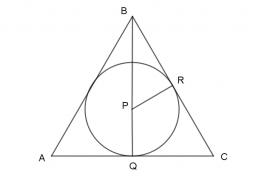Volume ratio
Calculate the volume ratio of balls circumscribed (diameter r) and inscribed (diameter ϱ) into an equilateral rotating cone.
Correct answer:

Tips for related online calculators
You need to know the following knowledge to solve this word math problem:
Units of physical quantities:
Grade of the word problem:
We encourage you to watch this tutorial video on this math problem: video1
Related math problems and questions:
- A cone 4
 A cone with a radius of 10 cm is divided into two parts by drawing a plane through the midpoint of its axis parallel to its base. Compare the volumes of the two parts.
A cone with a radius of 10 cm is divided into two parts by drawing a plane through the midpoint of its axis parallel to its base. Compare the volumes of the two parts. - Orange juice
 Water and orange are mixed in a ratio of 7:4. An amount of 36 cm³ of orange is used. What volume of water is used?
Water and orange are mixed in a ratio of 7:4. An amount of 36 cm³ of orange is used. What volume of water is used? - Smoothie 2
 David is using 100 ml of pineapple juice to make a smoothie. He needs to use a pineapple juice to orange juice ratio of 2: 5. How much orange juice should he use?
David is using 100 ml of pineapple juice to make a smoothie. He needs to use a pineapple juice to orange juice ratio of 2: 5. How much orange juice should he use? - 2-cycle
 2-cycle engines require a mixture of oil and gas to run properly. For every gallon of gas, a certain 2-cycle engine requires 1 1/4 fl oz of oil. How much oil must be added to prepare 3 1/2 gallons of gas to get the proper mixture?
2-cycle engines require a mixture of oil and gas to run properly. For every gallon of gas, a certain 2-cycle engine requires 1 1/4 fl oz of oil. How much oil must be added to prepare 3 1/2 gallons of gas to get the proper mixture? - Anneta
 Anneta wants to buy a piece of land for farming; she wants to use 1/3 of the land to plant cocoa, 2/7 for a Palm plantation, and the rest for a vegetable plantation. 1). Find the fractions of the land used for vegetable plantation 2). If one wants to use
Anneta wants to buy a piece of land for farming; she wants to use 1/3 of the land to plant cocoa, 2/7 for a Palm plantation, and the rest for a vegetable plantation. 1). Find the fractions of the land used for vegetable plantation 2). If one wants to use - Dimensions 81805
 The soap has the shape of a cuboid with dimensions of 6 cm, 4 cm, and 2 cm. Katy used it for a week and all the dimensions of the soap shrunk by half. How long will her soap last?
The soap has the shape of a cuboid with dimensions of 6 cm, 4 cm, and 2 cm. Katy used it for a week and all the dimensions of the soap shrunk by half. How long will her soap last? - Salt water
 The ratio of water (in liters) to salt (in grams) needs to be 3 to 2. If we add 10 grams of salt, how much water do we need to add?
The ratio of water (in liters) to salt (in grams) needs to be 3 to 2. If we add 10 grams of salt, how much water do we need to add? - Solution mixtures
 We have 1 liter of 80% solution. Every hour, pour 1 dl of the solution, add 1 dl of water (a 0% solution), and mix. What percent solution will we have after two mixings?
We have 1 liter of 80% solution. Every hour, pour 1 dl of the solution, add 1 dl of water (a 0% solution), and mix. What percent solution will we have after two mixings? - Ice cream
 Two and a half liters of ice cream are divided (unequally) into two parts that are in the ratio of 1:7. How much is each part?
Two and a half liters of ice cream are divided (unequally) into two parts that are in the ratio of 1:7. How much is each part? - Blueberries 79284
 Lenka, Jane, and Michael collected blueberries in the ratio of 3:4:2. Lenka collected 4.5 liters of blueberries. How many blueberries did Jane and Michael collect?
Lenka, Jane, and Michael collected blueberries in the ratio of 3:4:2. Lenka collected 4.5 liters of blueberries. How many blueberries did Jane and Michael collect? - Car uses
 The car uses 91 liters of petrol to travel 700km. Determine the rate in liter per 100km.
The car uses 91 liters of petrol to travel 700km. Determine the rate in liter per 100km. - A car 6
 A car holds 15 liters of fuel. The car consumes 3 liters of fuel each 100 km. We started a trip of 350 km with a full tank of fuel. How much fuel remains in the tank at the end of the trip?
A car holds 15 liters of fuel. The car consumes 3 liters of fuel each 100 km. We started a trip of 350 km with a full tank of fuel. How much fuel remains in the tank at the end of the trip? - Car fuel
 Tanya drove 3 1/2 hours and used 1/3 tank of gas. For how long could Tanya drive using a 1/2 tank of gas? Enter your answer as a mixed number in the simplest form in the box.
Tanya drove 3 1/2 hours and used 1/3 tank of gas. For how long could Tanya drive using a 1/2 tank of gas? Enter your answer as a mixed number in the simplest form in the box. - Two pots
 Two similar pots have 16 cm and 10 cm heights if the smaller pot holds 0,75 l. Find the capacity of the larger pot
Two similar pots have 16 cm and 10 cm heights if the smaller pot holds 0,75 l. Find the capacity of the larger pot - Quadrilateral 70294
 The edge lengths of a quadrilateral prism are in the ratio a: b: c = 2:4:5. The surface of the prism is 57 cm². Calculate the volume.
The edge lengths of a quadrilateral prism are in the ratio a: b: c = 2:4:5. The surface of the prism is 57 cm². Calculate the volume. - Manufacturer 67024
 The car manufacturer states that the car consumes an average of 6.8 liters of gasoline per 100 km. How many liters of petrol does it use for a 348 km journey?
The car manufacturer states that the car consumes an average of 6.8 liters of gasoline per 100 km. How many liters of petrol does it use for a 348 km journey? - Right-angled 66364
 From a rectangular board with 2 m and 3 m dimensions, we cut isosceles and right-angled triangles at the corners with an overhang of 40 cm. Calculate the ratio of the rest of the board's areas to its total original area.
From a rectangular board with 2 m and 3 m dimensions, we cut isosceles and right-angled triangles at the corners with an overhang of 40 cm. Calculate the ratio of the rest of the board's areas to its total original area.
